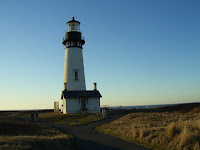
One of the most beautiful spots on the Oregon Coast is Heceta Head Lighthouse. Just after you drive south past Sea Lion Cave on Highway 101 you come to a turn-out on the west side of the road. You must stop! Get out of the car and walk up to the edge. Across the bay to the south is the Lighthouse sitting out on the edge of the head. To the right, sitting behind a white picket fence is the keeper's house. The head keeper's house was torn down after the light was automated. But luckily, the assistant's house sit remains. It was constructed as a duplex serving the families of the two assistant keepers. The common wall that separated the dining room has been torn down to allow the building to become a bed and breakfast with a most spectacular setting. 
Once a year, for the two week ends prior to Christmas, the keeper's residence is decorated and lights are hung and the entire site is open to the public from 4-7 on Saturday and Sunday evenings. In addition to the period style decorations, there is live music provided by local musicians, hot drinks (coffee, tea, hot chocolate) and cookies and bars to enjoy. After enjoying the ambiance of the house, R & I walked to the gift shop to check find many treasures. Then it was stroll up to the tower itself. I had remembered to bring a flashlight so several visitors walked with us in the dark up to the lighthouse. A volunteer greeted us in the work room and told us the story of the light and before taking us up the stairs to see the light itself.
and before taking us up the stairs to see the light itself.
The 56 foot tower was constructed in 1894. The light pattern is a flash every 10 seconds. Because the light is 205 feet above the ocean, the light can be seen 21 miles out to sea, rated as the strongest light on the Oregon Coast.

Once a year, for the two week ends prior to Christmas, the keeper's residence is decorated and lights are hung and the entire site is open to the public from 4-7 on Saturday and Sunday evenings. In addition to the period style decorations, there is live music provided by local musicians, hot drinks (coffee, tea, hot chocolate) and cookies and bars to enjoy. After enjoying the ambiance of the house, R & I walked to the gift shop to check find many treasures. Then it was stroll up to the tower itself. I had remembered to bring a flashlight so several visitors walked with us in the dark up to the lighthouse. A volunteer greeted us in the work room and told us the story of the light
 and before taking us up the stairs to see the light itself.
and before taking us up the stairs to see the light itself.The 56 foot tower was constructed in 1894. The light pattern is a flash every 10 seconds. Because the light is 205 feet above the ocean, the light can be seen 21 miles out to sea, rated as the strongest light on the Oregon Coast.














































